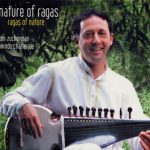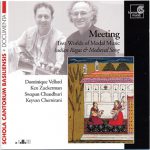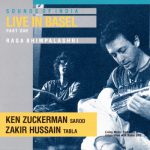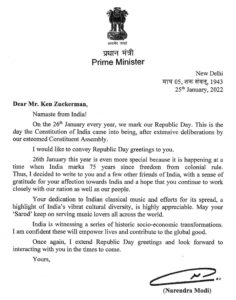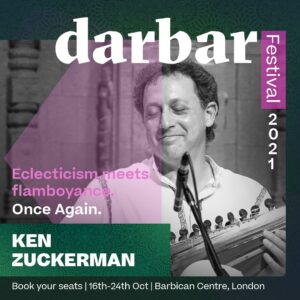Indian Express
Bombay / January 16, 1992
Ken enthralls
Not since the late John Higgins, dubbed Bhagavathar for the virtuosity in Carnatic music, has a western exponent of Indian music so taken our music world by storm as Ken Zuckerman, whose sarod recitals have the unmistakable touch of a maestro. It is little wonder though, because 39-year-old Ken has been under the tutelage of Ustad Ali Akbar Khan, the sarod maestro, for over 20 years and presently heads the Ali Akbar College of Music in Basel, Switzerland. The Ustad himself calls Ken ‘one of my most gifted students’ and has accorded Ken the honour of performing with him on the same platform. The audience of Dadar Matunga Cultural Centre was a witness to Ken Zuckerman’s phenomenal handling of the sarod.
Ken started with reposeful alaaps in the mid-afternoon melody, Madhuvanti. From the innate delicacy of his touch, may his very attitude to Hindustani music, it was at once apparent that Ken has assimilated within himself the very ‘soul’ of Ali Akbar’s artistry. Playing with his head down and total concentration (like his Ustad) Ken conjured up the self-same improvisations in an unhurried development of the raga. There was a logical progression of the alap, jod, and jhala followed by a gat set to Teental in which he received understanding support from Aneesh Pradhan on tabla. He followed it up with a Pilu which was marked by imaginative passages reminiscent of the Maihar maestro. The sitarkhani gat was set to Addhataal.
The post-interval session was dominated by a hauntingly beautiful Durga – a raga which has unaccountably, receded into oblivion. Ken’s interpretation of Durga was a rare revelation with a gat set to Roopak and then coupled with a ‘sum-to-sum’ drut composition of Baba Allauddin Khan. Ken concluded his recital with a Mishra Mand which was highlighted by delicate phrasing off innovative swar-sangatis – then he gradually decelerated into a ‘fade out’, but the memory of his concert will endure. Credit equally goes to young Aneesh Pradhan who kept a low profile in his support on tabla. As or Ken, his sarod recital could well serve as a model for our contemporary exponents of the sarod: it was an admirable recreation of the intrinsic values one has cheishe in his Ustad’s sarod baaz – and happily free of present-day gimmickry.
Sumit Savur
Indian Express
The Times of India Bombay / January 10, 1992
Enthralled listeners
Ken Zuckerman has been internationally acclaimed as one of the finest sarod virtuosi. He received training from Ali Akbar Khan for 20 years, and it seems as if the music of the maestro flows in this veins. He presently directs the Ali Akbar College of Music in Switzerland.
Although a westerner, he has imbibed the spirit of Indian classical music to the nth degree. He has complete command over swara and laya and possesses a very keen aesthetic sense. His notes are crystal clear and he projects the image of the melody in its pristine purity investing it with exquisite meends.
Zuckerman opened his recital with a leisurely alap in raag Madhuvanti followed by a madhya-laya gat with excellent layakari and several well-conceived tihais. In the drut gat he built up the climax with an elegant jhala.
The short alap and a captivating gat in raag Piloo were presented by the artiste in notes depicting the sentiments of longing and pathos.
In a soft, sylphlike alap and in a breezy gat in raag Durga the artiste enthralled the listeners with the delicate nuances of swaras emanating from his instruments.
The concluding piece was a delightful dhun in raag Mishra Mand enriched with a fine flavour of the folk-music of Rajasthan.
Aneesh Pradhan’s tabla accompaniment was superb.
By Batuk Dewanji
Dadar Matunga Cultural Centre, January 5
India Tournee 1994
ZUCKERMANS’ RARE TREAT
Times of India, Ahmedabad
Indian Express, Ahmedabad :
Ken Zuckerman’s sarod recital featured some of the most prized qualities in Hindustani music that audiences look for: a balance of swara and laya, clarity of conceptualisation, richness in elaboration, variety in technique….It was an exquisite rendering…masterful but restrained layakari, exercised without compromising musicality…vintage Ali Akbar, exquisitely played.
National Mail, Bhopal:
ZUCKERMAN EXELS IN SAROD IN ALI AKBAR’S STYLE
Deccan Chronicle, Hyderabad:
The lovely taans came out with effortless ease.
Indian Express, Hyderabad :
WESTERNER SHOWS HIS MASTERY OVER SAROD…Ken Zuckerman, one of the finest sarod players, was trained for nearly 20 years under Ustad Ali Akbar Khan and captured the soul of Indian music just like a born Indian….The tonal quality of Zuckerman’ sarod is refined and his style is totally gimmick-free.
Newstime, Hyderabad:
KEN AWAKENS PRISTINE PURITY WITH SAROD….The sarod recital of Ken Zuckerman…transported listeners into a trance.
Twin City Guide, Hyderabad & Secunderabad:
Ken Zuckerman regaled the audience with crystal clear notes
The Independent, Bombay:
AS SOFT AS A FEATHER…Ken Zuckerman’s sarod recital was delectable.
THE TIMES OF INDIA BOMBAY JANUARY 1 1995
CONCERT WITH A TOUCH OF CLASS
by Mohan Nadkarni
Ken Zuckerman: Sarod
Kala Bharati
January 1, 1995
Ken Zuckerman, the Swiss sarodist and senior disciple of the maestro Ali Akbar Khan, has come a long way since he began his annual concert visits to this country nine years ago. His two hour performance under review carried, without doubt, a touch of class.
The opening Nat Bhairav, which is, incidentally forte with most sitarist and sarodist, was a charming amalgam of traditional restraint and inspirational freedom. The alap was limpid and communicative, while jod and jhala showed the variety and range of the artist’s imagination. The gat was no less striking for its clarity and speed. The fast gat jhala passages were replete with saturated resonance’s.
The get in Jaunpuri, heard next, was equally expressive for its melodic import, which was now caressiveness, now persuasive, now sad and pensive. An incredible performance by any standards and doubly so, because it comes from one who is equally well groomed in Western music. He has now attained a degree of musicianship to a point where he should deservedly find place in major sangeet sammelans in the country.
Nayan Ghosh’s partnership with Zuckerman on the percussion was marked by dignity, softness and restraint this time. It was imbued with a spirit of camaraderie between the two and that is as it should be.
India’s best known Hindustani music critic, Mohan Nadharni has been a writer on music for the last 40 years, and has reviewed well over 1000 concerts for the Times of India.
The Times of India
Bombay, January 11, 1996
Finesse and sensitivity
Ken Zuckerman
Shruti-Gunjan
Dahisar (West), January 7
The Basel-based sarodist and senior disciple of the sarod maestro, Ali Akbar Khan, was in fine fettle at this three-hour performance, comprising the raags Puriya Dhanashri, followed by Gorakh-Kalyan and Janasammohini, Hemant and Kirwani. Although brevity was the keynote of all his offerings, each one carried his conspicuous musicianship. It was reflected in the kind of aesthetic balance that marked their portraiture. Except for the opening Puriya Dhanashri, which was portrayed in the conventional phases of alap, jod and gat movements, the other numbers were set to medium and fast tempo and cast in varied taals, often of much complexity. Here he showed his grip over the rhythm which was provided by the noted percussionist, Madan Mishra. Deserving of special mention is his skill and imagination in the use of sonant and consonant notes and conjuring up other phrases and sequences characteristic of each raag. There was, besides, a plenitude of tonal grace and rhythmic elegance in all his numbers. He showed a marked striving for nobler effects. His approach was free from those purposeless, irritating tricks of style which are often seen to beset many an Indian instrumentalist. The concert, presented before a compact audience of 200, accommodated in the baithak style, had the ambience of an old-world jalsa where active listener participation’s a vital factor in the success of a performance.
By Mohan Nadkarni
INDIAN EXPRESS AHMEDABAD THURSDAY, JAN. 11, 1996
SAPTAK MUSIC FESTIVAL
One foreigner who astounded his Ahmedabad audience by his virtuosity in Indian instrumental music at the Saptak festival was Ken Zuckerman, a visiting Swiss artiste. It is no overstatement that the 43-year-old, after years of practice under the renowned guru Ali Akbar Khan, fully vindicated the guru-shishya parampara which he learned from his distinguished mentor, both in music as well as in his personal life. In his native country he runs a music school named Ali Akbar Khan School. In its form and fashioning the unfolding alap jor and jhala and the faster gat compositions in rag Hemant, Zuckerman demonstrated how the melody could proceed from the tranquil grace gathering steady momentum. The final effect that merged was simply grand in its impact. Ustad Hidayat Khan, who had exhibited mettle as a solo player on the third of the current 10-day musical extravaganza, deserves fullsome praise for adroitness and skill to make Zuckerman’s sarod recital as yet another memorable one for his appreciative audience. P. Subramanian
Saptak festival, an annual event, takes place in Ahmedabad during the first ten days of January.
It is now one of the largest music conferences in India.
How his sarod gently sings
ASIAN AGE, April 26, 1996
Had Ken Zuckerman played his sarode behind the curtain, I would have thought he was one of the ten promising Indian disciples of Ustad Ali Akbar Khan. The “maihar touch” in his music is not superficial but a product of deep involvement backed up by systematic hard labour. It is this sincerity that makes it difficult to believe that he is not an Indian by birth unless one hears his name or sees him play.
Even before his first stroke, the tuning of the sarode bears ample evidence of the guru shishya communication, for the instrument has the echo of the sound of Khan Sahib. The systematic approach to alaap, the formation, the pause, the punctuation, all point out to the dhrupad based sargam talim which treat a raga as a complete whole. Patches, however colourful, are not meant to be complete in themselves but a part of a complete whole, a means to end not an end in themselves. The correct pauses, giving the notes the appropriate dose of importance, contribute to a very systematic raga picture presentation and one marvels at the precision, accuracy, and spontaneity in Ken Zuckerman’s sarode playing.
Like migratory birds, this American sahib comes to this city every winter giving concerts not only in posh Calcutta concert halls but also places like Salkia in Howrah. One such concert featured ragas Hemant and Kirvani to the delight of the listeners. Both the alaaps and gaths were wonderfully played, clear, bold, correct and full of feeling.
Bravo American sahib!
Subroto Roy Chowdhury
The Hindustan Times
January 30, 1996
Ken’s fine Keerwani
The impossible becomes achievable when unbounded capacity for hard work is coupled with talent of a high order. Few can hope to plumb the depths of the ocean that is Indian classical music; most barely skim the surface. Listening to Ken Zuckerman on the sarod at IIC, one was humbled by the realisation of just how long and hard he must have worked to provide such aesthetically articulate music. One was awes by the quality of his talent, for boundaries of country, language and custom were swept away by the passion of his determination to master not only a difficult, fretless instrument, but also the mysteries of classical music.
Drut rousing a in framed piece, third the of taans during hilt to highlighted was and commendable, is laya grasp inherent Ken?s arose. opportunity when brilliance length rare solos injecting tabla, clear remarkably percussed Mazumdar Uday pleasing. imaginative both variations, diverse with skillfully embroidered were teentala jhaptala gats The audience. pulse felling warily, treading he though as almost careful, sounded initially but superb, technically alaap-jor notes. shuddha straight, out appeal magical raga wove who Maihar, Khan Allauddin Baba Guru, father his it for Khan, Akbar Ali Ustad under tutelage reflected choice item. main Hemant Raga chose.
The composition itself deserved a special word – it has been put together with concern for raga structure and delineation. The concluding jhala was well-rendered, with each delineation. The falling clearly on the ears despite the speed. Though Ken’s performance was strictly within traditional confined and technically sound, expressing the power and brilliance of his playing, somehow the feeling of being immersed in his music did not quite come through. The soul had yet to be reaches and touched.
This slightly regretful feeling melted away when Ken moved on to raga Keerwani. The poignancy of the raga came through in full measures, the typical ‘chalan’ self-evident. one was amazed at the tremendous speed with which Ken tuned his instrument with such shard accuracy each sympathetic string was in perfect resonance. The first gat in roopak madhyalaya allowed listeners to warm up to the mood the musician was building up, filled with fine note patterns. The following gat was in an interesting, 14-beat chachar tala Uday on the tabla maintained the rhythmic and capably, and added his talented touches. The concluding item in rapid teental had Ken jumping from saptak to saptak with ease and assurance. The taans were well structured and the jhala was short but sweet.
Ken has achieved what very few Indians have – become a worthy disciple of Guru Ali Akbar Khan. Surely this is the highest tribute a student can pay a teacher; to prove himself worthy of receiving knowledge and utilising it to the full. It is also the acid test of a Guru, to be able to inspire a disciple to such heights of excellence.
Bandana Malhotra

